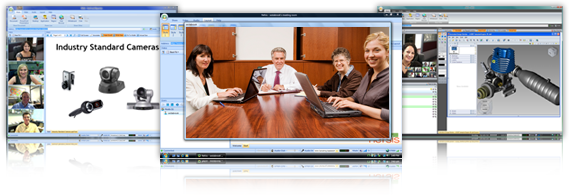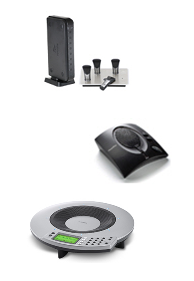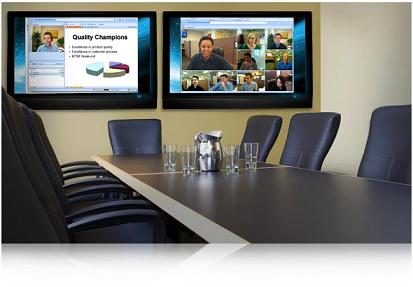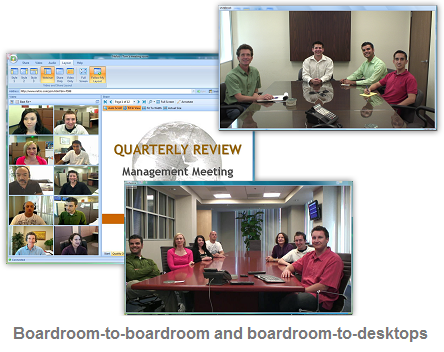
Video Conference Room Design & Boardroom Setup Tips
For best acoustics and video quality
within budget
This article is a guide outlining the points and factors you need to consider when designing your video conference room.
Each room is different and most of us want to build the perfect video conference room. We are, however, confined to stay
within our budget and this can limit some of our decisions.
The goal of this article is to help you build your video conferencing room without going overboard. Regardless, if you
want an extravagant looking room or if you are on a tight budget, the factors are the same. These factors include lighting
conditions, room décor, and external factors like air vents and wall material. Again, this is just the starting point,
so let's begin.
Décor
Color Palette
As with most corporate office space, certain color schemes are conducive to the work environment and are visually
ergonomic. Some color schemes, however, can impede visual perception of the room. This in turn can cause users to lose
focus in the room, and some to have headaches and feel fatigue.
In selecting the color palette for your video conferencing room, neutral shades such as beige, tan, pale gray or a pale
slate blue work best. These colors provide the best ergonomic background and reduce eye strain when viewing the video images.
You should avoid stark whites and the darker palettes which do not provide optimum background for viewing. Whatever your
color scheme, remember muted pale tones are best. Any vibrant color can reflect light and cast a hued pallor onto the
individual's video image.
Wall Finishes
Painted, papered or fabric walls can be acceptable wall finishes for your video conferencing room. They offer a calm
atmosphere for all the participants. However, be sure the selected color falls within the parameters of the color palette
mentioned previously.
Painted walls are best in a flat or semi-flat finish. Avoid gloss or enamel finishes as they reflect light. If you decide
to use a paper or fabric finish, avoid tight, intricate patterns, such as striping, checks or tight swirls. These patterns
can cause the video image to appear distorted and flicker rapidly. Users participating in your video conference will find
this effect unpleasant to their eyes. As with paint finishes, shiny wall coverings are also problematic because they reflect
light. Paper or fabric wall finishes in a muted, pale color palette with no texture or minimal tone-on-tone texture are
optimum.
Furnishings
Furniture and decorating accessories should be kept to a minimum. Bear in mind wall hangings within range of the camera
should not have reflective surfaces. Materials such as mirrors or glass fronted framed prints reflect light and may cause the
camera to overcompensate the brightness in the room. This also holds true for credenzas with glass or mirror-fronted hutches,
and glass-topped tables. Keep the accessories in the room at a minimum because they can be distracting; and in some cases,
your system could use more bandwidth (due light changes).
When you select tables and chairs for the room, be sure to consider the functionality of each piece. A case in point would
be smaller enterprises where the room may be multi-purpose. If the room is used solely for video conferencing, set the tables
and chairs in a horseshoe or semi-circle configuration. In this arrangement, remote sites can view all your participants
easily; an optimum setup for meetings and discussions.
Alternatively, you can arrange the tables and chairs in a rowed design, making the room appropriate for training,
presentation, and discussion formats. Note: Your Company's requirements will determine which seating arrangement is most
appropriate.
Windows and Window Treatments
Selecting an interior room without windows for your video conferencing room is often a luxury that cannot be accommodated.
Sunlight can disrupt the camera's ability to capture a good image, and it can make viewing a conference difficult as glare
may overcome the brightness on many display screens and monitors. If you have the option, take an interior room. For rooms
with exterior windows, the window treatments such as vertical blinds or drapes should contain a solar-blocking or blackout
to prevent glare. As with wall finishes, refrain from window treatments and fabrics that have patterns, and opt for finishes
and fabrics in solid, muted pale tones.
Lighting
Regardless of lighting fixtures selected, the goal is to use an evenly lit space with minimal shadowing. Additionally,
there should be no direct lighting aimed in the direction of the \amera lens. Diffused fluorescent fixtures work well, as do
indirect candescent fixtures, which allow for a dimming feature. Stark, direct lighting, such as indoor spotlights, which cause
heavy shadowing, do not work well in a video conferencing environment. Often a combination of indirect candescent and diffused
fluorescent will offer the most lighting flexibility.
Conference Room Equipment Requirements
Audio Equipment

Reverberation and echo can distort audio signals. This is the main reason professional recording studios are designed with
sound absorbing materials. Material such as carpet, draperies, fabric covered vertical blinds, and fabric wall coverings work
best for video conference rooms. In addition, ceilings with sound-proofing tiles will lessen reverberation or acoustic echo
effect.
Microphones specifically designed for video conferencing are highly sensitive. As long as the conference room microphones
are centrally located, most microphones will capture sound within eight feet of the device.
Avoid moving the microphone while in the conference; doing so may defeat echo cancelation, resulting in reverberation or
squawking, a major source of distraction during a productive meeting. While many video conference microphones are typically
placed in the center of the conference table, some large rooms may require several inputs, including ceiling and/or wall
mounted microphones. Microphones placed near speakers will result in feedback noise, and deliver an unpleasant experience.
For more information in this topic, please visit our
video conferencing equipment page, and for large conference rooms, the section on multiple inputs, wiring diagrams,
echo cancellation hardware and mixers.
Visual Displays
 There are two basic display types available for video conferencing, projectors or flat screens. Projectors can cover a larger
view and cost less than a flat screen. There are, however, several issues to consider. Glare from windows, or overhead
lighting may reduce the quality of the image being projected. In a room where the lights are too bright, the only solution for
a projector is to use a model with very high lumens. Lumens are the ratio of lamp brightness against the ambient light in the
room. Projectors with high lumens are expensive and may not be economical for some companies. In addition, some high-powered
projectors have loud fans. While this type of noise is easily defeated by Nefsis audio, the fan raises the ambient noise-level
for your in-room participants.
There are two basic display types available for video conferencing, projectors or flat screens. Projectors can cover a larger
view and cost less than a flat screen. There are, however, several issues to consider. Glare from windows, or overhead
lighting may reduce the quality of the image being projected. In a room where the lights are too bright, the only solution for
a projector is to use a model with very high lumens. Lumens are the ratio of lamp brightness against the ambient light in the
room. Projectors with high lumens are expensive and may not be economical for some companies. In addition, some high-powered
projectors have loud fans. While this type of noise is easily defeated by Nefsis audio, the fan raises the ambient noise-level
for your in-room participants.
The alternative to projectors is a flat screen, which can either be LCD or plasma. Both of these flat screen options operate
in varied light conditions, and the impact of ambient light on image quality is minimal. They typically work well in any evenly
lit rooms and provide a clarity that is not possible with mid-grade projectors.
Regardless of the display you select, the minimum screen size should be 52", although larger screens of 60-72" are
preferable, especially for larger rooms. Most video conferences done today are displayed in standard resolution, but HD
(high definition) screens are becoming more common. Investing in a higher quality screen now allows you to prepare for technical
advancements without having to upgrade your components in the future.
Dual Monitors
Dual monitors are becoming as popular in conference rooms as they are in high-production desktops. Dual, or multiple monitors,
are useful with Nefsis and good quality video conferencing applications because they allow the meeting host to put the agenda,
items being shared, and one or more videos on separate monitors. In addition, the use of multiple monitors can also mimic an
in-person meeting, or put more emphasis (e.g., full-screen) on the primary speaker.
Tying it all Together: Video Conferencing Software & Online Services

Nefsis is a standards-based, video conferencing software and online service solution for business. You can start a
free trial anytime.
Nefsis customers enjoy multipoint video conferencing, with mixed webcam, HD and pan-tilt-zoom (PTZ) conference room camera
inputs. In addition, Nefsis security, proxy and
firewall traversal provide worldwide connectivity to virtually any business desktop worldwide.
Since Nefsis is broadly compatible with video
conferencing equipment, and it dynamically adjusts to available bandwidth
(scalable video), Nefsis can be used
in combination with any of the conference room décor, audio inputs, and video camera choices mentioned on this page
— thus accommodating a wide variety of physical room dimensions, layouts, design challenges and budgets.
We invite you to explore
Nefsis Internet conferencing features,
case studies and the detailed topics menu on the left.
Conclusion
There are many ways to achieve your video conference room design goals and stay within your budget. This article is just
an overview and a starting point. The tips presented here should give you a good baseline for where to start, and it may have
answered some of your questions. Every room has its own unique characteristics, but these general concepts should address
the design challenges faced in most rooms.
Should you have any questions, or if you require any assistance with your Video Conferencing project, please
contact us.
FREE Consultation: Schedule a Live Video Conference and See Desktop-to-Boardroom Setups From Your Own Office
Click here to schedule a live demo and see Nefsis video conferencing for
yourself, right from your own desktop, when most convenient for you.
 We can easily demonstrate multiparty video conferencing using webcams and high-end equipment; and mixed desktop and conference
room setups.
We can easily demonstrate multiparty video conferencing using webcams and high-end equipment; and mixed desktop and conference
room setups.
 Nefsis is remarkably easy to use, and
requires only a PC and Internet access to run a trial. You can click the free trial
button at right, or contact us with any questions you may have.
Nefsis is remarkably easy to use, and
requires only a PC and Internet access to run a trial. You can click the free trial
button at right, or contact us with any questions you may have.